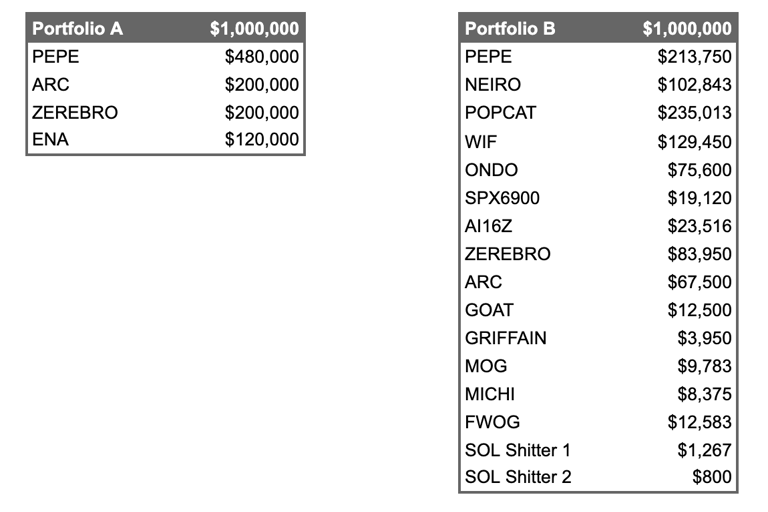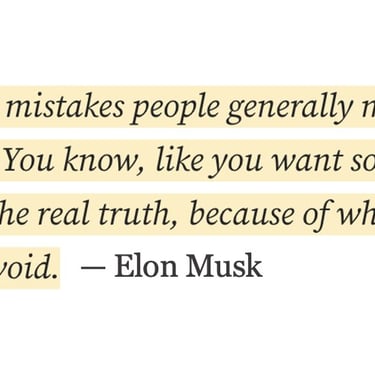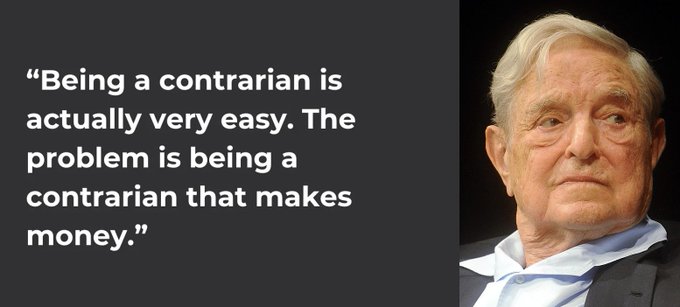Portfolio Management, Execution, Psychology - Level Up your Game 🔰
A thread on Portfolio Management, Execution, & Psychology to level up your game. Presenting 8 mental frameworks to cut through the noise and become a sharper, more focused, and structured trader
RESDEGEN 📊🐵
@resdegen
1/6/20258 min read


An article on Portfolio Management, Execution, & Psychology to level up your game. Presenting 8 mental frameworks to cut through the noise and become a sharper, more focused, and structured trader:
1. Take The 100% Cash Test
To optimize your portfolio allocation, at least to the best of your ability, ask yourself this critical question:
—If your portfolio were to reset to 100% USDT today, would you choose to reallocate funds exactly into the same positions you currently hold?—
The answer for most people is probably not. Yet, many struggle to act. Why? Because of these psychological barriers:
The Sunk Cost Fallacy
Emotional Attachment
Fear Of Being Wrong
The Sunk Cost Fallacy is the cognitive bias where people continue to invest time, money, or energy into something simply because they've already invested in it, even when it's no longer logical (this can also apply to relationships, projects, etc).
In trading, this means holding onto underperforming positions because you've already "spent so much" on them—whether financially or emotionally—rather than cutting losses and reallocating to better opportunities.
Ask yourself the question. If the answer is no, you need to act.
It can feel overwhelming at first, but start small, with 1 position: ask yourself if you would buy that exact amount of that token today. Then go with a 2nd one.
Selling is emotionally difficult because it feels like closing the door on potential. But clinging to positions based on hope or fear leads to stagnation and poor judgment.
2. Maintain a Structured Portfolio
Clear categories for better management:
Core Positions: High conviction plays; you should be able to handle the violent swings. It doesn't necessarily mean you need to hold long term, as opportunity cost is very expensive in this market with aggressive rotations, but you'd be lying to yourself if you think you can time every single move. Believe in something.
Trading Positions: Short to medium-term opportunities meant to capture specific trends or price movements. Allows for more flexibility: faster rotations and tighter invalidations.
Trading style might different for everyone—this isn't referred to a perps account. I can buy an onchain play, swing it for 4x from $5m to $20m, and move on. And I won't care it goes higher later, but that's only cause I predetermined my mind to understand the type of trade I was taking.
If I expected it to hit $1B (eg. due to uniqueness), it would go to Core Positions and I'd be okay when I roundtrip 50% as I understand that such a volatility is the price for outsized returns.
Mixing these two often leads to confusion and emotional decisions. By separating them, you gain clarity about the purpose of each position, avoiding regrets.
3. Fewer, More Concentrated Plays.
Underrated skill that only the greatest traders can master. It's probably the secret to promoting from one big league (eg. 6 figs) to another (eg. 7 figs).
Truth is that sizing up with conviction and compounding those gains has created more real millionaires —who have managed to keep their wealth over time— than any meme coin.
Every trade you take should impact your portfolio. Otherwise, it's not worth taking.
Fewer plays help you with portfolio management and avoid the traders' worst fatigue—hesitation. Making decisions about 15 different bags leaves you mentally exhausted.
But if you restrict yourself on having a few plays (let's say, max 5), you'll wonder: is this play that shared this random degen really worth buying?
Sometimes, though, it can also be a very asymmetrical bet (ie. risk 1-2% but possible getting a 20-40% portfolio impact). It's simply that you shouldn't spread out randomly.
While a few people get rich with a few plays, others all they do is to simply collect dozens of meaningless pumps. "The pump collector"—I call it.
TLDR
You should take very asymmetric bets, and/or size up properly with conviction & compound; anything in between isn't gonna cut it.




4. Build Your Portfolio by Asking First What Your Goals Are.
Your portfolio should always reflect your financial objectives.
If your goal is to grow from $200k to $2M this bull run (I know $2m is not enough to retire but still), every decision should get you closer to that target. Ask yourself:
Does this trade contribute meaningfully to my goal?
or am I chasing a pump just to avoid feeling left out?
Lack of focus can derail your judgment. Throwing $5k into every play might sound tempting, but consider the trade-offs:
–It likely won’t meaningfully impact your portfolio.
–It will consume disproportionate time and energy (eg. 20% of your mindshare for a 1% allocation).
Most people buy something and hope for that play to hit the magical number they have in mind: "I need to make 10x with this coin". Wishful thinking is called, and it's not your friend.
Instead, know your goals, and understand whether you are working towards them. Cannot emphasize this enough.


5. Focus On Your Edge
You’ve reached this point by leveraging your strengths—stick to them.
For example, I leveled up my portfolio by hitting and compounding several onchain winners. As portfolio grows, liquidity might become a concern, but scaling into higher market caps isn’t always the answer.
When you move up the ranks, you’re competing against participants with sharper, more specialized edges in those larger markets. Don’t assume a bigger portfolio magically makes you an expert perps trader.
If your success came from onchain plays, keep playing the game. Unless your portfolio grows significantly ($5M–$10M+), liquidity likely won’t be an issue: 7-8 figs LPs + 7-8 figs 24h volume.
Similarly, if you're killing it with memes or AI plays on Solana and Base, there’s little reason to buy that new farm on Sui.
Assuming there's not an inflection point and your trend keeps going, venturing into unfamiliar territory often leads to:
Low conviction: You’ll allocate less capital due to risk aversion.
High effort: Learning the ropes in a new domain consumes a lot of mental bandwidth.
Which takes me to my next point.


6. Do Not Be a Contrarian
Unless you are George Soros or GCR. Hint: you are not.
Being a contrarian is alluring because those who have successfully spotted such inflection points are recognized, and reputation is highly sought (eg. LUNA top, market cycle top, SOL bottom).
But being a contrarian only pays off at pivotal turning points. In a bull run, when momentum builds, you need to be adding fuel to the fire; not trying to extinguish it.
Trying to anticipate every pivot point is not only stressful but also statistically unlikely to succeed. Let's be realistic anon, otherwise you wouldn't be in X reading this.
Focus on being in the game and compounding your wins rather than trying to outsmart the market at every turn.
In a bull market, momentum is your ally—don’t fight it. Play the trend, take profits when it’s over, and leave contrarian heroics to the history books. The goal is not to be a market prophet; it’s to grow your portfolio.
Said differently:
Better to roundtrip slightly and confirm a trend than to sit out entirely and miss massive opportunities.


7. Have a Thesis, an Invalidation, and Detach Yourself Emotionally From Tokens.
Tokens are simply vehicles for achieving financial growth—they are not loyal, nor do they "care" about you. When evaluating opportunities, document your rationale and strategy.
a) Thesis
Why are you buying this token?
Is it a catalyst-based trade?
Are you betting on an asymmetry of information or that the market has fundamentally mispriced it?
Or is it just fomo from seeing your fav KOL shill it?
b) Invalidation
Identify clear criteria that will force you to close your position—whether it’s a specific price, time, or change in market conditions.
Detach your feelings from the investment. Remember, it’s not personal; it’s business.
Imagine this scenario:
Let's say you bought token XYZ for $50k, went to $200k, now back to $50k—assume your thesis was invalidated. Your portfolio was $500k and now it's $350k after the December local top.
You have two options:
1] Hold your underwater bags, waiting for a pump that lacks any clear justification, just to recover your unrealized PnL, or
2] Reset the bag, cut your losses, and reallocate to a better opportunity.
The ultimate goal is increasing your portfolio value, regardless of which token delivers those returns. If you see a better opportunity, rotate. If that new play 2x's, the regret over the previous token will fade. It’s about results, not loyalty to a particular coin.
Forget about promises, hopes, dreams, and wishful thinking. Selling a coin doesn't mean it's over—you can always buy it back.
Sounds easy but crypto is one of those places where people get extremely attached to their investments—actually a feature of the space if you know how to leverage it.
But you have to work towards your goals: increase your portfolio value.
It doesn't matter which tokens you get your returns from.
Profit maxi >> community member.
8. Detach Outcomes From Process & Avoid Punishing Yourself
The outcome of a trade doesn’t define whether it was a good or bad decision. A good trade is one made with the best information and reasoning available at the time—not just one that ends in profit.
Assuming you didn't gamble and instead approached a trade with:
a thesis
an invalidation
a proper risk management and a clear understanding of whether it was a core or a trading position
and favorable conditions: solid R:R or asymmetric potential
then you made a sound decision, regardless of the result.
Avoid Punishing Yourself for Outcomes
It’s easy to spiral into self-criticism after a loss, but this mindset often ignores the quality of the process.
Losses are simply inevitable and even great trades can fail. Bad ones can sometimes succeed!
I’ve fallen into the trap of excessive self-blame too, only to later realize that the trade was logical and aligned with my strategy.
This often leads to high pressure, poor judgement, hesitation, emotional trades, and a downward spiral that makes you think that you do everything wrong, or that others are simply doing always better than you.
Closing Thoughts
Well, this got a bit longer than I thought, but I hope it can be useful for many. I know there's tons of extra things I could have added but man I have a market to trade.
Anyways, it's been helpful to me writing this down after many hours reflecting on my mistakes.
What's done is done. The only thing to look forward to is the future. Past decisions were made so that you could make better decisions next time, not to let them consume you.
If you've been doing well until now, great. If not, good too, there's no way to learn in this market without failure—there's a price to pay for every success story.
Remember: it’s not about how many pumps you collect, not even about who makes the most money. It's about how you play each hand, whether you reach your goals, and most importantly, whether you keep your money when everything collapses.
See you in the trenches fellow degen.
Link to the original tweet: https://x.com/resdegen/status/1876319473969606957